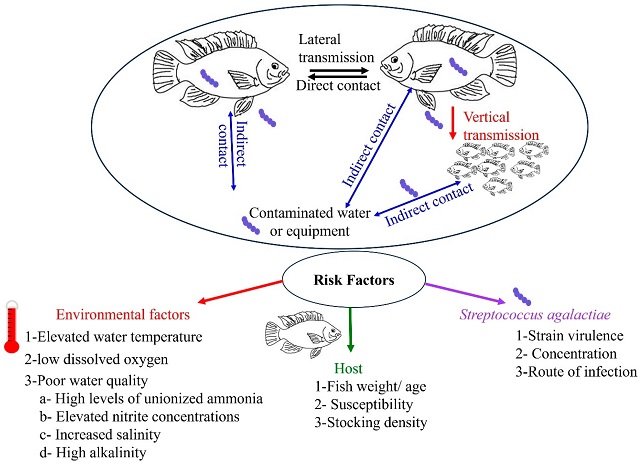The tilapia aquaculture industry has been grappling with outbreaks of streptococcosis, a disease that causes significant economic losses. Despite advances in the prevention and control of streptococcosis, no effective measures have been identified.
To shed light on this challenge, a study led by scientists from the Chinese Academy of Fishery Sciences and Nanjing Agricultural University has delved into the molecular complexities of disease resistance, focusing on hybrid tilapia (Oreochromis niloticus ♀ × O. aureus ♂), which exhibits greater resistance to Streptococcus agalactiae, a common culprit in streptococcosis outbreaks, than Nile tilapia (O. niloticus) and blue tilapia (O. aureus).
The scientists performed a comparative transcriptome analysis in the spleens of hybrid tilapia, Nile tilapia, and blue tilapia that were challenged or not challenged with S. agalactiae.
Comparative transcriptome analysis
Using cutting-edge comparative transcriptome analysis, the researchers examined the genetic landscapes of hybrid tilapia, Nile tilapia, and blue tilapia 48 hours after infection.
The findings revealed the astonishing number of 1982, 2355, and 2076 differentially expressed genes in hybrid, Nile, and blue tilapia, respectively, shedding light on nuanced genetic responses to streptococcal infections.
Activated pathways
Functional enrichment analysis discovered a plethora of metabolic and immune system-related pathways activated in all three tilapia lines.
In particular, the study highlighted the differential expression of genes associated with crucial pathways such as phagosome, focal adhesion, cytokine-cytokine receptor interaction, and toll-like receptor signaling. These pathways were identified as key contributors to the robust resistance observed in hybrid tilapia.
Suppressed immune response genes
The study revealed a fascinating aspect of the hybrid tilapia’s immune response strategy.
Stay Always Informed
Join our communities to instantly receive the most important news, reports, and analysis from the aquaculture industry.
The researchers found that genes associated with immune responses, including P38, TLR5, CXCR3, CXCL12, PSTPIP1, and TFR, were generally suppressed under normal conditions but were selectively induced after exposure to a pathogen.
This adaptive response mechanism provides unique insights into the sophisticated strategies employed by hybrid tilapia against bacterial infections.
Implications for tilapia breeding programs
These innovative findings not only expand our understanding of the molecular mechanisms underlying S. agalactiae tolerance in hybrid tilapia but also offer valuable information for tilapia breeding programs.
By identifying specific genes and pathways associated with increased disease resistance, researchers can inform specific breeding strategies to develop more resilient tilapia strains, ultimately strengthening the aquaculture industry against streptococcosis outbreaks.
Conclusion
In the dynamic field of tilapia aquaculture, understanding the genetic foundations of disease resistance is crucial. The study was the first to compare the transcriptome profiles of hybrid tilapia, Nile tilapia, and blue tilapia in response to S. agalactiae.
“These results will enhance our understanding of the molecular mechanisms underlying S. agalactiae tolerance in hybrid tilapia and provide valuable information for tilapia breeding,” highlighted the researchers.
They also conclude that “The differential expression of specific genes associated with phagosome, focal adhesion, cytokine-receptor interaction, and TLR signaling pathways contributed to the resistance of hybrid tilapia.”
The study, through a comprehensive transcriptome analysis, reveals the intricate molecular mechanisms that empower hybrid tilapia with increased tolerance to Streptococcus agalactiae. The research was funded by the Central Public-Interest Scientific Institution Basal Research Fund, Freshwater Fisheries Research Center, CAFS, and China Agriculture Research System.
Contact
Hong Yang
Freshwater Fisheries Research Center, Chinese Academy of Fishery Sciences
No. 9 shanshui Road, Wuxi, 214081
Jiangsu Province, China.
Email: yanghong@ffrc.cn
Reference
Jinglin Zhu, Zhiying Zou, Dayu Li, Wei Xiao, Jie Yu, Binglin Chen, Hong Yang. 2023. Comparative transcriptomes reveal different tolerance mechanisms to Streptococcus agalactiae in hybrid tilapia, nile tilapia, and blue tilapia, Fish & Shellfish Immunology, Volume 142, 2023, 109121, ISSN 1050-4648, https://doi.org/10.1016/j.fsi.2023.109121.
Editor at the digital magazine AquaHoy. He holds a degree in Aquaculture Biology from the National University of Santa (UNS) and a Master’s degree in Science and Innovation Management from the Polytechnic University of Valencia, with postgraduate diplomas in Business Innovation and Innovation Management. He possesses extensive experience in the aquaculture and fisheries sector, having led the Fisheries Innovation Unit of the National Program for Innovation in Fisheries and Aquaculture (PNIPA). He has served as a senior consultant in technology watch, an innovation project formulator and advisor, and a lecturer at UNS. He is a member of the Peruvian College of Biologists and was recognized by the World Aquaculture Society (WAS) in 2016 for his contribution to aquaculture.




